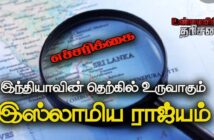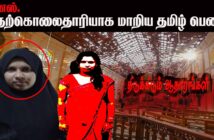The word Eelam is not invented by the Tamil militants and not to be considered as a derisive word. In fact, the story of Eelam is the history of the Tamils itself.
The history of the Tamils, is the story of the Eelam. The history of the world is not complete, if the true story of the Tamils and that of the Eelam is not included. Up to date, a few historians wrote bits and pieces about the Tamils and Eelam, but those details did not constitute the complete story. The present history of the World is a Western interpretation. Western historians have purposely distorted the history to suit their own ends. To write the true story, the endeavor demands extensive research to uncover the distorted, deliberately ignored details, and to compile the discarded facts and the missing pages into a true historical treatise.
Thiruvalluvar the great Tamil poet, in the opening chapter of his treatise on moral aphorism called Thiru Kural, wrote in the first chapter “Praise of God” and in the very first Kural (prosody, a unit of two line verse, called couplet or distich) ” ‘Aah,’ is the first letter of alphabets, God is primordial to earth.” He gave God the supreme position, as one that existed ever since.
Now the question arises regarding the emergence of the world. According to Rig-Veda, the Aryan concept, the world emerged from, Soonya, which means from the Void or Nothingness :-
Then even nothingness was not, nor existence,
There was no air then, nor the heavens beyond it.
Who covered it? Where was it? In whose keeping?
Was there then cosmic water, in depths unfathomed?….
But, after all, Who knows, and who can say,
Whence it all came, and how creation happened?
The gods themselves are later than creation,
So who knows truly whence it has arisen? –
[“The Wonder That was India,” by A.L.Basham, – Rig Veda Translation]
Earlier, the entire land area of the world formed one continent. Later, due to grave impact of the Lunar and Solar gravitational pull, including other violent process that took place deep inside the earth’s core, which includes lateral movements and the drifting, caused the split of the continent into two proto-continents, Laur Asia – the Northern hemisphere, that includes Europe, North America, greater part of Asia and Gondawanland – the Southern hemisphere. Geologists believed that a great continent called Gondawanland composed of South America, Africa, India, Australia and Antarctica. Researchers concluded that, Gondawnland remained as one single continent for nearly 300 million years, subsequently after 180 to 150 million years, it began to break up.
Many millions’ years after the break up of the Gondawanland, a land-mass named Lemuria continent emerged, for the first time surrounded by the ocean. This land-mass that came into existence, was the old Oriental continent that stretched in unbroken land formation from Madagascar to Malay Archipelago, to Australia, including Polynesia and northwards to the present valley of Ganges. The Ganges valley, earlier occupied by the sea, spreading westward across Persia (Iran), Arabia (Middle-east) and the Sahara regions, (Sahara in Arabic language means Desert – the North African Desert is called Sahara Al Kobra in Arabic which means big desert or grand desert.) forming the southern limit of the Palae-Arctic Continent, that embraced Europe, North Africa and Europe.
The land-mass of Lemuria, the eastern part of the Gondawanland, took credit for the human evolution. Paleontologists, gave Lemuria great importance as the place from where man emerged. According to findings, the ape – Homo-Erectus evolved into man – Homo Sapiens, from Lemuria.
Three Phases
Three phases in the human history were recorded before the knowledge and use of metals, are often distinguished as, the Eolithic Age – or the early period of the Stone Age, when crude stone tools were used, followed by Paleolithic Age – when primitive man used unpolished chipped stone tools and finally the Neolithic Age – characterized by primitive farming and the use of polished stone, flint tools and weapons. An advance state of a society began to emerge, when man became a farmer, but gradually through the interaction with the fellow human beings in a creative way led to the emergence of the human civilization.
“…They were an ancient
civilized human race
lived during the early
Neolithic period, eight
thousands years before
Christ….”
The earliest people to form the real cities in the world were those who lived in the region between the Euphrates and the Tigris river basins. The land bordering and between the Euphrates and Tigris rivers was called Mesopotamia. Historians consider the people who lived in the lower Mesopotamia as “mysterious” people and called them Sumerians, in short, Sumers. Western Historians had simply ignored the language they spoke as agglutinative, which has no clear or close relationship to any known language family. Later, researchers concluded that, the Sumers as proto-Dravidians. Even today, historians are not that comfortable to accept Sumers as Dravidians, described in the historical parlance, speakers of Thamil or Tamil, an eternal language, acclaimed as pioneers of human civilization.
Sumerians
Sumerians were neither Aryans, nor Caucasians, and not even Semites, furthermore from where they originated, nobody knows, moreover they were characterized as mysterious people. Their brown complexion, locks of long dark hair, the language they spoke and the kind of writing – the first of it’s kind, they used to scratch upon clay tablets, clearly differentiated their individuality and confirmed them of being belonged to the proto-Dravidian origin. When their writing deciphered, it became apparent that, they were not a distinct ethnic group, but were proto-Elamites. Ela or Illa denote earth and Elamites means “Earthly people.”
Sumer is the ancient name for Southern Mesopotamia. Sume in Tamil means, the word denoting “a country” and Sumer means “those who live in a country.” The name Mesopotamia derived from Greek word, Mesos -middle and Potamai means -Rivers and so literally means, ‘between the rivers. Sumer does not indicate any special ethnology, but people who lived in the country. The capital of Sumer was Ur. This is also a Tamil word, referring ‘a city,’ or ‘a place of abode of people,’ or ‘a settlement’.
During the Protoliterate period (3200 – 2850 BC), the city states dominated by the temples emerged and writing was also invented. The earliest writings were in the form of pictograms, or simplified pictures on clay tablets, usually baked after inscribed with a reed. Subsequently, their writing gradually evolved towards cuneiform, a way of arranging impressions stamped on clay, by the wedge-like section of a chopped-off reed. Name of places, cities and other names clearly indicated them as the early form of Tamil. Available information leaves beyond doubt, that Sumerians spoke Tamil, as spoken in the pre-historic days.
Deep roots
Sumerian civilization had deep roots. The people lived in villages and also had a few cult centers. One of the cult center was located at Eridu, probably originated in about 5000 BC. It grew steadily and by the middle of the fourth millennium, there was a temple, which provided the original model of the Mesopotamian monumental architecture, but today only a platform where it rested remains to be seen.
Excavation conducted at Eridu, beneath the earliest Sumerians buildings and foundations revealed that, there existed an early Neolithic culture, before the invention of writing or the use of bronze amidst the other ethnic groups in the rest of the world. They used to harvest agricultural crops by earthenware sickles. Researchers concluded that, pre-Sumerian people were proto-Elamites and confirmed their findings, when they discovered similar Neolithic remains at Sausa, once the capital of Elam.
The word Sausa in Tamil means “cleanliness,” therefore Sausa means a clean city. (Elam, Ilam and Eelam are the corruption of the same word. Western authors and historians modified foreign names according to the predilections of their tongues. Confusion of the name became inevitable as the Western historians were neither Elamites nor Tamils.)
On the other side of the Tigris, lived Sumerians’ neighbors, the warlike people, called the Elamites. The name of the country was Elam (Western historians became accustomed to the pronunciation of Elam based on their transliteration of the word), and those who lived in the country were Elamites – the earthly people, who influenced the civilization, culture, writing and economy of the ancient Sumers. They were the ancient civilized human race, lived during the early Neolithic period, eight thousand years before Christ. Elamites were the first to use the “Wheel” for transportation. The invention, a forerunner to the industrial revolution, but the Western historians credited the invention to the Summers, who adopted it at a later stage.
Khuzistan, a region in Iran, located in the east of the Tigris, presently identified as the location of Elam. Elamites were Negroid and there was a strong Negroid strain in them. Elamites’ civilization flourished some 8000 years ago with city-states, distinctive culture and a written language. The language of the Elamites, after analysis found phonetically and morphologically similar to that of the Tamil.
Earlier, Elamites had a pictorial graphic writing system, called pictograms, followed by hieroglyphics. After the middle of the third millennium BC, most of the Elamites texts discovered were in the cuneiform scripts. According to research, it became apparent that, Elamites spoke a language cognate with that of the Tamil. Western historians felt that crediting Tamils of being the pioneers of human civilization, may not place them in any advantageous position, therefore Elamites became a forgotten race and today Persian (Iranians) lives in the ancient land of Elam, once roamed by the glorious descendants of the Tamils.
“…Elamites were
Negroid and there was a
strong Negroid strain in
them…”
Again, historians identified the Elamites in the Sahara region, located in the northern Africa. Sahara was once an inhabitable region, consisted of vast grassy plains and luxuriant forests, traversed by rivers with extensive swamps. It was the home of pastoral peoples herding cattle, sheep and goats. In those days, before 3000 BC, what is now a stretch of a largest desert and arid canyon, was a fertile Savannah region, intersected and drained by rivers running down to Niger and by another system running nearly seven hundred and fifty miles into Lake Tehad.
The region earlier had also a large lake called the Triniton Lake, almost bordering the Northern shores of Africa. Due to a cataclysm, the European-African isthmus breached and forced the waters of the Triniton lake to flow into the land-locked Mediterranean sea. When the lake and other rivers, that once traversed the fertile plains of Sahara flowed into the Mediterranean sea and elongated it, the region began to dry up and by 1250 BC, the entire region turned into an arid zone, that led to the emergence of the world’s largest desert. When Sahara began to dry-up, the people who lived in the region disappeared. What happened to them?
The Sahara Settlements
After the World War II, scientist began to explore the Nile valley region in the Sahara area and discovered traces of the early human existence, the “Asselar Man.” While a section of the Elamites remained stationary in Elam even before 2500 BC, a large section, according to the migratory tendency of the early civilized men, were on the move. Elamites suddenly disappeared from the Euphrates and Tigris river basin. What happened to them? Elamites, a people who possessed a tradition and civilization older than that of the Sumerians, suddenly vanished from the original Elam. We do not know what happened to them. They seem to have been overrun and the population absorbed by conquerors. Whilst the Elamites were in Elam, even before the Great Flood, they were also identified contemporaneously in the Sahara region, and whilst being in Sahara, a section of them was on a constant move migrating all over. They were on the move through the Ural mountain regions, ultimately established themselves in India by entering through the North-west. Their dispersal ranged from Central Asia to the Mediterranean region in Africa, Islands in the Aegean Sea, into Eastern Europe, ultimately to India and beyond.
Elamites, described as long-headed from front to back, (dolichocephatic) mixed with short-headed from front to back (brachycepphalic) the Armenoids, along their migratory routes and established themselves in India before the 5th millennium BC. Those immigrants might have possibly come into prolonged contact with the Ural-Altic (Ural – Hungarian, Finnish; Altic-Turkish, Mongol) speakers, thus explaining the striking affinities between the Tamil language and Ural-Altic language groups. Subsequently, this particular race of people, the Elamites, spread eastward, through the East-Indies to Polynesia, Australia and beyond. Tamils lived in those countries, before the Neolithic period pioneered the evolution of the human civilization.
In 1816, Francis W.Ellis, a British civil servant was the first European to recognize the distinctiveness of the Tamils and their eternal language family. For him and to the rest of the Westerners, Tamils became a newly evolved human race. Later, in 1856, Robert A. Caldwell, in his, “A Comparative Grammar of the Dravidian or South Indian Family of Languages,” used the Sanskrit word ‘Dravidian’ to name the independent family of the Tamil language group. Caldwell based his interpretation of the word Dravida, according to a 7th century Sanskrit text, to mean Tamil.
Caldwell failed to explain as to why he called the Tamil family of languages with a Sanskrit word, when it is already has a name and called as “Tamil”. Many consider it a disgraceful arrangement to name one of the greatest, oldest and eternal, an independent language group, with a Sanskrit word. Many scholars found the word Dravida derisive, unfortunately, Tamil scholars have failed to rectify the injustice done to the oldest language family.
On the other hand, Dravida is purely philological and is a name of a linguistic family and is not an isolated linguistic group, with uninterrupted continuity over a period of more than Ten thousand years, covering the period from the proto-Elamites, pre-Mediterranean, pre-Hammito-Semitic, up to the present day. The language, considered one of the oldest, eternal, spoken by the mankind from the very day the human civilization emerged, but still young and vibrant, spoken even today by more than 80 million speakers scattered all over the world.
When the Elamites were identified in India, their earlier distinct ethnicity was completely ignored, but after the19th century, ethnologists identified them as Dravidians, based on their language, as the speakers of Tamil. Even though, the Tamils’ ethnic identity continuously transform, they continue to stake their claim of being the oldest civilized nation, based on their linguistic and cultural continuity.
A great Cataclysm
In the early ages, the name Manu, applied to 13 successive mythical progenitors and sovereigns of the earth and two of those Manu descendants were Saman and Elam (Ilam). Saman was the brother, who ruled the northern portion of the sub-continent, while his sister Elam, ruled the Southern portion, consisting of Thonda Nadu, Vanda Nadu, Kapatapuram, Elamandalam (later called Eelam or Ilankai), Madura and Viramahendrapuram. Due to a great cataclysm, a vast portion of the Southern India submerged under the sea. The first Tamil Academy, (Sangam), located at the Southern Madura too submerged about 2500 years ago, before the birth of Christ. Due to the flood, Elamandalam separated from India, emerged in the form of an island and this island is Eelam.
Regarding the great deluge and the separate entity of Eelam, several Tamil literary records are available and the following are few of those recorded evidences:
“The Cruel ocean engulfed the river Pakhruli and a row of hills including the mountain Kumari.” – Cilapathikaram – Chapter 11:20-21.
“In order to compensate the area lost to the sea, king Pandia moved tirelessly, to other lands and captured them.” – Kalitokai
“The roaring sound of the ocean water trembled the peak of the mountain.” – Kuruntokai
“Before the ocean engulfing, lies few countries, and the southern boundaries were described.” – Ilampuranar – a commentator of Tolkapiam.
P.E.P.Deraniyagala, a former Commissioner, Department of Archeology, in his lecture on “Some Aspects of the Fauna of Ceylon (Sri Lanka).” delivered at the Royal Asiatic Society on 28 May 1965, describes on the geographical isolation of Ceylon as follows:
“The presence of Jurassic deposits both in the North-western Ceylon and in the Ramnad district of India shows that the two were once connected, but since the island lacks many of the consecutive deposits, it appears to have broken off from the mainland during this period. The two countries became reattached by early Miocene times, but shortly afterwards they broke away again, and several such unions and separations have occurred. During each interval of isolation, plants and animals had evolved new subspecies which had invaded the neighboring country whenever the land connection was renewed.”
“Geographical isolation is one of the essentials for subspecies formation and in living things the amount of latent ability to undergo future modification is termed ‘plastic’ whereas a species that no longer respond to the environment and is unable to modify itself has reached the limits of its plasticity and should be designed “constant” or “fixed.”
“Although geologists generally consider Ceylon to be a part of one of the most stable areas of the earth, this view is only partially correct and some parts of the Island have undergone alteration as will be seen from the following:
(1) Early records mention that there were about a hundred Islands off its coasts (Fahien 410 AC) and also that there was a large Island named Giri adjacent to it, which had disappeared (Skanda Purana and Dipavamsa).
(2) Portuguese record mention heavy earth quakes with explosion and the formation of numerous fissures.
(3) The disappearance of many Islands that appear in Dutch and early British maps has been studied and attention drawn to their inability, to the oscillation that is so evident towards the North-west of Ceylon and the elevation of the Negambo beach area.
(4) The raised beaches from Mundel and Eluvankulam areas to the north-west and others in the South-east.
(5) The ring of waterfalls in the highlands indicate that they have been produce by recent thrust.
(6) The river gravel in the North-western and Northern provinces and pot holes especially in the Southern and Eastern provinces which are now remote from the rivers that had produced them.
(7) Submarine canyons at the mouths of such rivers as the Daduru, the Valave, the two Maha Oyas, the Galoya and Mahavilli.
(8) Borings in the Bere lagoon near Colombo have revealed alternate layers of marine, fluviatile and swamp conditions of Pleistocene age.
(9) The rivers frequently display river captures and a change of their courses, e,g, Mahaveli and Valave rivers.
(10) The original beds of some of the larger rivers such as the Kalu and Kalani rivers are ten to twenty feet lower than the sea bottom from their mouths up to a distance of about a mile inland.
(11) The abundance of thermal and mineral springs.
(12) The presence of diamond, chalcedony and natural glass.”
“Geological movements such as faulting, tilting and dislocation that occurred during the last few geological periods are among the more important factors that have influenced evolution, especially after Ceylon had become isolated.”
Confirming P.E.P.Deraniyagala’s findings that through the existence common fauna and flora in Ceylon and in the South Indian coast of the earlier land links of Ceylon with India, S.U. Deraniyagala writes in his “The Prehistory of Ceylon, “The fauna and flora of peninsular India clearly suggest prehistoric land connects with Lanka at various times during the Quaternary, as firmly indicated by the presence of Elephas maximus, an Upper Pleistocene form, on either side of the Palk Starit. Land connections with the mainland would of course have been prime importance for prehistoric settlement of the island prior to the advent of seafaring.”
Compilers of Ceylon annals, purposely avoided the historical geography of the country. They have failed to analyze the geographical side of the time wrought changes that took place in the formation of the insular country. This study helps to know the past, as well as helps to reconstruct the past more vividly. The geographical study of the pre-historic era of Ceylon, illuminates the physical evolutionary changes that took place in the landscape of the country from the very ancient period provides a vivid picture of the early inhabitants, whether they were there when the country separated, or they migrated after the separation and how they happened to live in the island, along with other details, such as the pre-historic society, their social interaction, civilization, the government and all the other details needed to discern a pattern of the past, to conclude the true historical background.
The Bible
Mention regarding the origin of Eelam as an insular country, is also found in the Holy Bible. The Bible describes that Elam, ‘became the maritime nation with a separate language.’ Genesis 10, The Descendants of Noah-
1These are the families of Shem, Ham, and Japheth, who were the three sons of Noah; for sons were born to them after the flood.
2The sons of Japheth were Gomer, Magog, Madai, Javan, Tubal, Meshech, Tiras.
3The Sons of Gomer,: Ashkenaz, Riphath, Togarmah.
4The sons of Javan, Elishah, Tarshish, Kittim, Dodanim.
5Their descendants became the maritime nations in various lands, each with a separate language.
21 Eber descended from Shem the oldest brother of Japheth.
22 Here is the list of Shem’s other descendants: Elam, Ashur, Arpachdad, Lud, Aram.
Following description is provided in The Holy Bible, Genesis 7:19, about the deluge, the greatest cataclysm recorded in the human history:
“All the tall mountains that were under the whole heavens came to be covered.” –
Also in, 2 Peter, 3:6,- “the world of that time suffered destruction.”
As indicated in the Holy Bible, the deluge occurred in the year 2370 BC. The flood began – “in the second month on the seventeenth day of the month.” – Genesis 7:11 The second month corresponds to the latter part of October and the first part of November on the present calendar. Many people around the world commemorate the ‘Day of the Dead’ or the ‘Feast of Ancestors,’ at the time of the year, to reflect the memory of the destruction caused by the Deluge and to remember the deaths.
After the deluge, according to The Holy Bible, descendants of Noah became the maritime nations of the world. One descendant is Elam, also a maritime nation.
The present Eelam, according to The Holy Bible, came into existence, after the Deluge. Therefore, the Eelam of today, is a creation by God, and according to The Holy Bible, the Elamites are a blessed maritime nation and not the earlier nation by the river basin as erroneously identified by the Western historians. The descendants of Elam, who descended from Noah and the maritime nation Elam came into existence, are both blessed in the Holy Bible and this act of God goes to prove the eternality of the country and the entire nation.
The people of Eelam had their own rulers after the country separated from the mainland India, due to the second universal deluge. The land-mass that separated from the Kumari (Comarin) continent called Elamandalam, came into existence as Eelanadu or Lanka, the resplendent country, in the midst of the Indian Ocean. As prophesied in the Holy Bible, the maritime nation of Eelam became a reality.
In conclusion, the word Eelam is not something suddenly invented by the Tamil militants and not to be considered as a derisive word. There is no Tamil Eelam or Sinhalese Eelam, but only the Eelam. Therefore, Eelam is the blessed name of the entire country, which is now being called Sri Lanka.
By K.T.Rajasingham,




